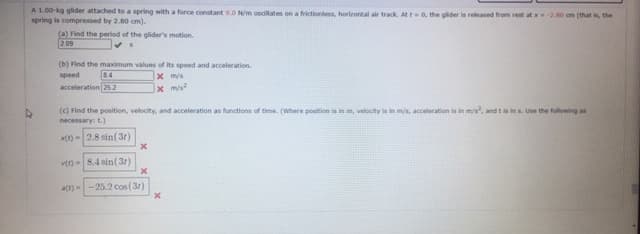A 1.00-kg glider attached to a spring with a force constant 9.0 N/m oscllates on a frictionless, horizontal air track. At tw 0, the glider is released from rest at -2.00 cm (that is, the spring is compressed by 2.80 cm). (a) Find the period of the glider's motion. 2.09 (b) Find the maximum values of its speed and acceleration. x m/s xms 8.4 acceleration 25 2 speed (c) Find the position, velocity, and acceleration as functions of time. (Where position is in m, velocity is in m/s, acceleration is in m/s, and t is ins. Use the following as necessary: t.) t) -2.8 sin(3r) ve) -8.4 sin( 31) a(r) -25.2 cos (3r)
A 1.00-kg glider attached to a spring with a force constant 9.0 N/m oscllates on a frictionless, horizontal air track. At tw 0, the glider is released from rest at -2.00 cm (that is, the spring is compressed by 2.80 cm). (a) Find the period of the glider's motion. 2.09 (b) Find the maximum values of its speed and acceleration. x m/s xms 8.4 acceleration 25 2 speed (c) Find the position, velocity, and acceleration as functions of time. (Where position is in m, velocity is in m/s, acceleration is in m/s, and t is ins. Use the following as necessary: t.) t) -2.8 sin(3r) ve) -8.4 sin( 31) a(r) -25.2 cos (3r)
Principles of Physics: A Calculus-Based Text
5th Edition
ISBN:9781133104261
Author:Raymond A. Serway, John W. Jewett
Publisher:Raymond A. Serway, John W. Jewett
Chapter12: Oscillatory Motion
Section: Chapter Questions
Problem 10P: A 1.00-kg glider attached to a spring with a force constant of 25.0 N/m oscillates on a...
Related questions
Question
Need help with the questions that have a red "x".

Transcribed Image Text:A 1.00-kg glider attached to a spring with a force constant 9.0 N/m oscillates on a frictionless, horizontal air track. Att0, the glider is released from rest at 20 cm (that is, the
spring is compressed by 2.80 cm).
(a) Find the period of the glider's motion.
2 09
(b) Find the maximum values of its speed and acceleration.
x m/s
84
acceleration 25 2
speed
(c) Find the position, velocity, and acceleration as functions of time. (Where position is in m, velocity is in m/s, acceleration is in m/s, and t is ins. Use the following as
necessary: t.)
x() - 2.8 sin(3r)
v) - 8.4 sin(31)
a(r)--25.2 cos (3r)
Expert Solution
This question has been solved!
Explore an expertly crafted, step-by-step solution for a thorough understanding of key concepts.
Step by step
Solved in 3 steps with 4 images

Knowledge Booster
Learn more about
Need a deep-dive on the concept behind this application? Look no further. Learn more about this topic, physics and related others by exploring similar questions and additional content below.Recommended textbooks for you

Principles of Physics: A Calculus-Based Text
Physics
ISBN:
9781133104261
Author:
Raymond A. Serway, John W. Jewett
Publisher:
Cengage Learning

College Physics
Physics
ISBN:
9781285737027
Author:
Raymond A. Serway, Chris Vuille
Publisher:
Cengage Learning

Physics for Scientists and Engineers, Technology …
Physics
ISBN:
9781305116399
Author:
Raymond A. Serway, John W. Jewett
Publisher:
Cengage Learning

Principles of Physics: A Calculus-Based Text
Physics
ISBN:
9781133104261
Author:
Raymond A. Serway, John W. Jewett
Publisher:
Cengage Learning

College Physics
Physics
ISBN:
9781285737027
Author:
Raymond A. Serway, Chris Vuille
Publisher:
Cengage Learning

Physics for Scientists and Engineers, Technology …
Physics
ISBN:
9781305116399
Author:
Raymond A. Serway, John W. Jewett
Publisher:
Cengage Learning

Physics for Scientists and Engineers: Foundations…
Physics
ISBN:
9781133939146
Author:
Katz, Debora M.
Publisher:
Cengage Learning

Classical Dynamics of Particles and Systems
Physics
ISBN:
9780534408961
Author:
Stephen T. Thornton, Jerry B. Marion
Publisher:
Cengage Learning

University Physics Volume 1
Physics
ISBN:
9781938168277
Author:
William Moebs, Samuel J. Ling, Jeff Sanny
Publisher:
OpenStax - Rice University